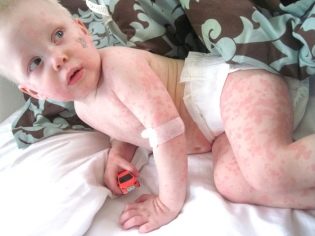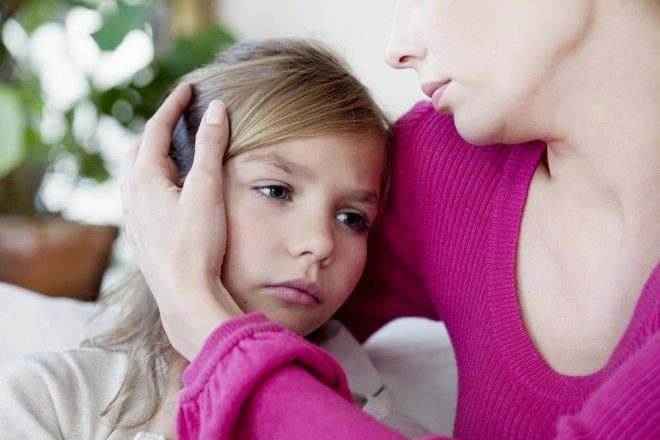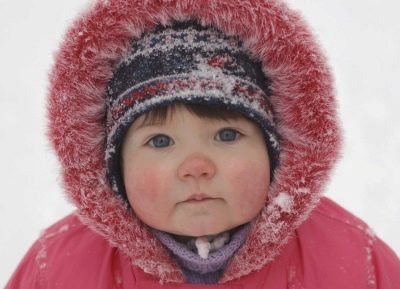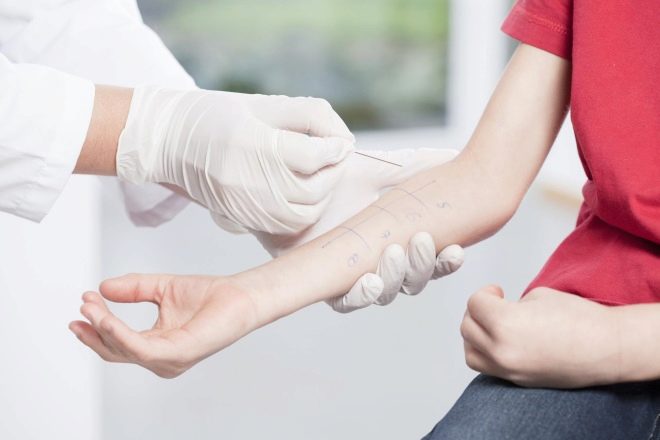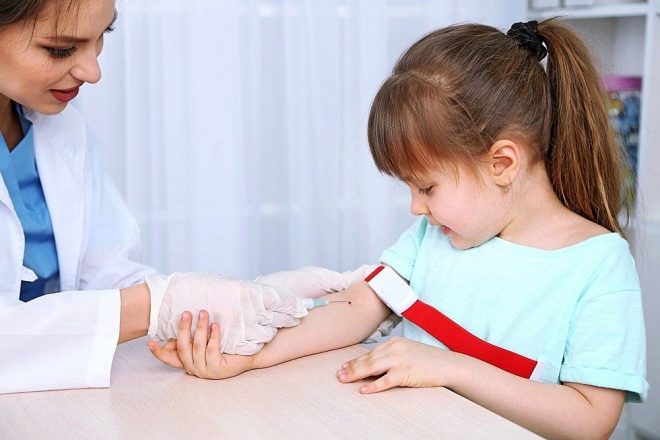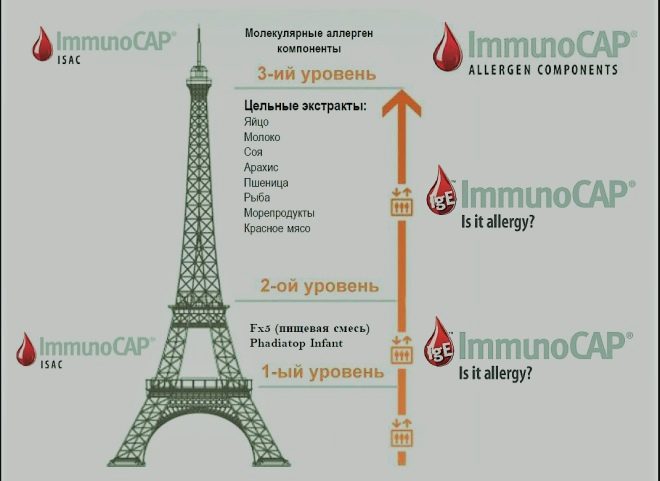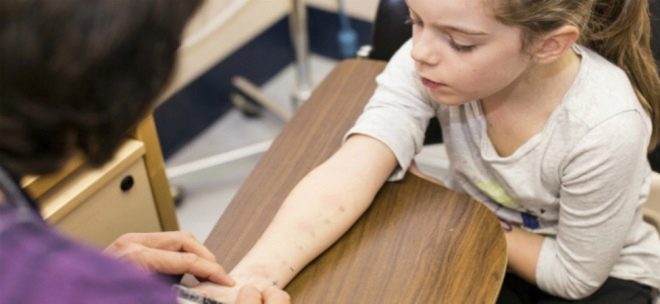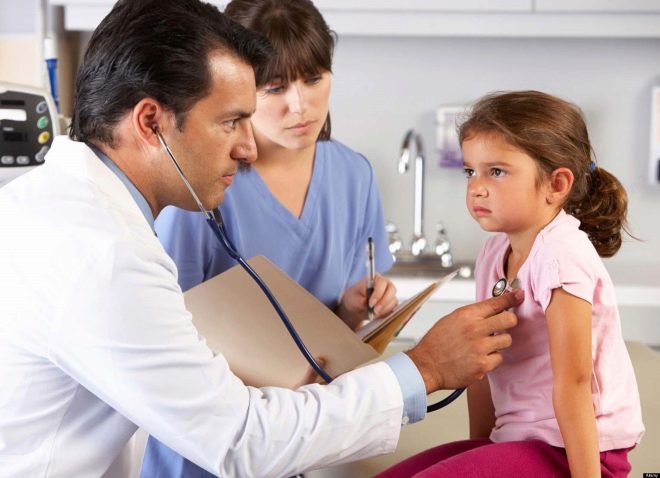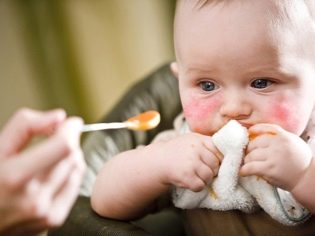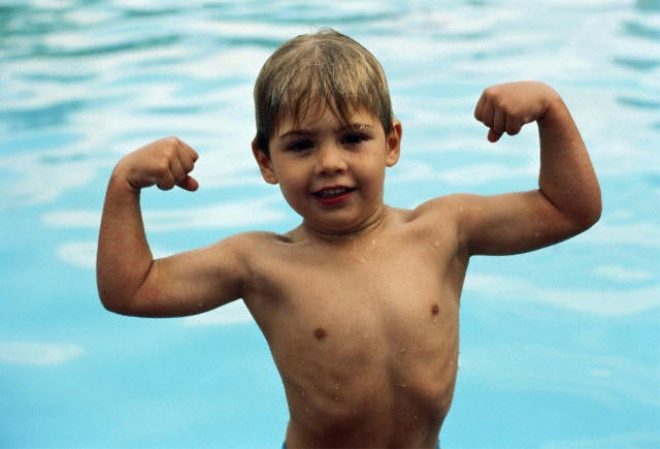Urticaria in children: from symptoms to treatment
Parents often experience urticaria in a child: urticaria, or urticaria, is common in childhood. Allergies are most common. The task of the parents is to be able to distinguish hives from other dermatological diseases and from viral infections in order to properly assist the child.
About pathology
Urticaria, or nettle fever, was called so for the external similarity of skin rashes with nettle burns. In fact, the disease is a dermatitis, in 99% of cases it is allergic. Blisters on the skin are formed rapidly, quickly, they itch, have a raised form, a pale pink color, which makes them very similar to traces of contact with nettle.
The prevalence of urticaria is extremely wide - according to some reports, up to a quarter of the entire terrestrial population has at least once encountered this form of dermatitis. More often affected children and women. According to WHO, the proportion of children with nettle among all allergy sufferers is at least 15%, while most often dermatitis, resembling nettle burns, occurs at the age of 2-3 years, 5-6 years. After 7 years, the urticaria is much less common, and after 9-10 years it often disappears altogether. If the contact with the allergen is permanent, the threat is not eliminated, then the nettle fever becomes chronic.
The people have a somewhat derogatory opinion about the urticaria - for some reason it is not considered to be a serious pathology. And in vain. The statistics, which the Ministry of Health has, says that in 40% of cases the appearance of urticaria on the skin is complicated by angioedema (angioedema), in which the laryngeal edema rapidly develops, the child may begin to choke.
With the closure of the glottis is not fatal, if assistance was provided out of time.
Kinds
Urticaria in children can be acute or chronic. The first is more common. After all, any reasonable and caring parent after the child becomes covered with a rash, begins to look for the source of the allergen, will try to limit contact with it. If this is not done, sensitization will become chronic. In this case, the rash will aggravate from time to time.
Urticaria is ordinary and artificial. In the first case, it occurs as a manifestation of allergy, in the second, it is the skin’s reaction to mechanical stress (if a child has something sharp on the skin, such as a nail, he has a swollen bulging band on the skin). Such a phenomenon in medicine has another name - urtikarny dermographism.
Urticaria - the concept is quite extensive. It includes several species that are mainly divided due to the appearance of a rash:
- dermographic;
- caused by pressure;
- cold (reaction to cold);
- vibration;
- cholinergic;
- contact;
- aqua.
Traditionally, mastocytosis (pigment urticaria), urticarial vasculitis and chronic genetically inherited cold urticaria are traditionally attributed to this disease. It is also possible the emergence of a rash on the nerve soil.
When asked whether such a rash is contagious to others, the answer is unequivocal: this is an allergy that does not pose a danger to other people, it is an individual immune response to a certain irritant that is relevant in this case for a particular child.
Why and how does it develop?
A characteristic rash, similar to a nettle burn, appears as a result of the accumulation of histamine, which is formed and deposited in mast cells of mast cells. The next collision with the antigen causes the mast cells to release histamine and throw it into the blood. This forms blisters. Each organism is able to sensitize at some speed, one person needs more time for this, another less. And because nettle rash appears as the first contact with a dangerous substance, and with repeated contact, and in this case, histamine accumulates gradually.
Capillaries become more vulnerable, their walls become more fragile, permeable, the intracellular fluid enters the outer layers of the skin. So there is a rash. And taking into account these processes, the urticaria is considered not a separate symptom, as many people think, but an independent disease.
Causes can be very diverse. Most common in childhood is food urticaria, when the rash is caused by a food allergen, insect bites. The characteristic nettle skin fever can manifest itself during blood transfusion and as a reaction to the vaccine that is used for vaccination. Drugs are considered one of the most likely factors for the development of urticaria. So the skin of the child can respond to household chemicals, chlorine contained in the water.
There are children who respond to cold or overheating with sunlight, to vibration, or mechanical friction (with clothes, a diaper, etc.) with an urticarial rash.
In 30% of cases, the true cause of the nettle fever in a child cannot be established.
Many parents think that urticaria is more susceptible to children who have intestinal parasites. Let's hasten to reassure: the studies did not confirm any significant role of helminthic invasions in the development of urticaria in children. And because the appointment of drugs against parasites just like that, just in case, common not so long ago, today is considered unreasonable and incorrect.
Symptoms and signs
There is a nettle fever in children always suddenly. Not from one blister, not from two. Immediately numerous rashes, quite extensive, blisters have a rich pinkish color. It is noteworthy that most of the rash in the initial stage appears during the first 60 minutes after contact with the allergen, while histamine content in the blood is significant. All that will happen in an hour is no longer so significant - if new blisters appear, then in an extremely small amount.
This is the main difference between urticaria and any infectious diseases. And all that parents need to remember is the time of rash spreading: if there is a lot at once, it is a question of hives, if one or two blisters and gradually, then an infection, such as chickenpox, should be suspected.
Another characteristic feature of the urticaria - the speed of extinction. As soon as the amount of histamine in the blood begins to fall, the rash will begin to fade and disappear without a trace. This usually occurs within a few hours. But there are options in which the “second wave” can start: as soon as the first rash quickly passes, a new one appears, just as extensive, perhaps in a different place.
If the form of the disease is chronic, such “waves” will replace each other with an enviable frequency, and the symptoms can be observed for several months.
Classic urticaria is quite painful. Elements of the rash itch, itch, give the child discomfort when touched, the skin around each blister is somewhat swollen, due to this, the elements merge into a large area of skin manifestations.The condition of the child depends on how extensive such formations are: if the rash appeared only on the priest or only on the hands, on the palms, for example, from contact with household chemicals, then the general condition is unlikely to suffer. If the rash is in the groin, on the face, it is a more painful condition. And if extensive foci of rash are found on the body, on the legs, on the back and on the stomach, the condition can be significantly disturbed.
Most often, the deterioration of health occurs due to subfebrile temperature, which occurs as a protective reaction to the release of histamine into the blood. A young child may experience an upset of appetite, stool, sleep, moodiness, crying. The older child has complaints of headache, malaise.
Each form of urticaria can have its own distinctive features in its manifestations.
Chronic
With chronic urticaria, the child often has associated problems with the state of the gastrointestinal tract, there are problems with the liver. The center of chronic infection may lie in the tonsils or gall bladder, as well as in the mouth, if the baby has advanced caries. In this case, autointoxication occurs. When a rash appears, they say about exacerbation, and often, especially in young children, with an exacerbation there is an increased nervousness and emotional instability, headaches, nausea, and even vomiting, disturbed stool, sleep. Sometimes an attack of chronic urticaria can lead to swelling of the meninges.
Infant
Urticaria, which occurs in infants, doctors call strophulus. It is always associated with nutrition - against the background of food allergic sensitization of the baby's body. Most often children with a nettle fever are prone to diathesis with the formation of weeping sores and eczema.
Those children who feed on adapted mixtures or those who are fed not according to age, most often have a rash in the form of vesicle nodules. Also, infant urticaria can be associated with insect bites (mosquitoes, flies). The size of the wheals is small - about 3 millimeters, on top there is a small bubble. Itching can lead to the fact that the child will begin to comb formation, which is dangerous bacterial complications.
In infants, the most common urticaria affects the skin in large folds, but an extensive rash that is widespread throughout the body is also not excluded. In addition, babies almost always experience stool disorders (diarrhea or, conversely, difficult bowel movement), as well as anorexia and sleep, they become more sluggish.
Giant
The synonym for this urticaria is Quincke swelling. The pathology is manifested not only by a sudden rash, but also by the same sudden edema of subcutaneous tissue, muscle tissue. The most dangerous swelling in the larynx, because it can lead to asphyxia.
Edemas are always located along the location of the muscles. They can stay for several days, after which they subside. If laryngeal edema occurs, the child begins to breathe with difficulty, his lips turn blue. It is necessary to act immediately: call an ambulance, take the child to the fresh air or open all the windows and doors to the street to ensure the flow of oxygen, if necessary, give one age dose of the antihistamine drug that the kid has previously consumed. A child in this condition needs urgent hospitalization.
Cold
This form of the disease is manifested in children, especially sensitive to cold, sunlight. Characteristic rashes appear after exposure to an appropriate factor. A child with an individual sensitivity, if his hands are cold on the street, blisters will appear on his hands. Sun allergies usually affect children with fair skin, blond hair and blue eyes.
A rash may also occur with a sharp temperature drop (from the summer heat, the child was brought into a room with a working conditioner or brought to a hot bath with frost). This form of nettle fever may well appear not immediately, but after a few hours or even a day after the temperature fluctuations.
Other forms
It is worth noting the toxic form of urticaria - an instant and immediate reaction to contact with certain chemicals, with some plants, animals. It is important to determine which substance the child has an inadequate response to exclude contacts. This does not mean that a person with intolerance to cats in childhood can never get a cat: as already mentioned, children tend to “outgrow” their allergies, only in 3% of allergy sufferers the immune response persists in adulthood. The rest get rid of allergies without a trace and may well eat oranges and stroke the kittens, feed aquarium fish and do everything they could not afford in childhood.
Diagnostics
An experienced doctor will always be able to recognize the hives "in the face", but an accurate diagnosis is made only on the basis of laboratory tests. Not always parents can remember that the child ate, drank, with which he had contact during the last 24 hours, and therefore allergological tests that are considered the most accurate method for determining the fact of sensitization of the body can help in finding the allergen.
Allergy tests do not always give an answer to the question of what exactly the child develops urticaria, because the most common, so-called standardized allergens are taken for them, and a particular baby may have a reaction to a different substance not included in the list of standardized ones.
The essence of the sample is reduced to the reaction to different allergens. On what will be the reaction - he is the "culprit" of nettle fever.
Modern medicine has several types of research that can be assigned to a baby. Most often, children are recommended immunological blood test.
For total immunoglobulin E
IgE is determined in the blood in the event that there is a sensitization. The level of immunoglobulin indicates its scale. Blood is taken from a vein. Parents should know that it is impossible to feed and feed the child before such an examination, and if the child is prescribed some medications for the purpose of the pediatrician and it is impossible to cancel them, the allergist must also be aware of this fact before blood is taken for analysis.
For specific immunoglobulins
Such a blood test is carried out by the child, if the fact of allergy is already established, but a specific allergen is not. The blood serum of a small patient is mixed with various allergens, for example, with plant pollen, animal saliva, house dust, etc. The reaction makes it possible to judge which group of allergens can cause a negative reaction in the child.
Immunocap
This test is carried out in the event that none of the previous ones could not give a clear answer to the question about the origin of allergies. For the study requires a greater amount of blood, but because the kids such an analysis is not prescribed. Most often, rely on the appointment of such a survey can only be from adolescence.
In addition to blood tests, skin tests may be recommended for a child with urticaria. Their passage may take time: in one session, the doctor can apply to the skin of a small patient no more than 20 types of allergens, and thousands of them. Samples are recommended for children over the age of three. The task of the doctor is to find the substance to which the skin will give a positive reaction. Allergen solutions are usually applied to the forearms, but the procedure can also be performed on the skin of the back. Babies put drops of solutions on the skin, and adolescents can make a few scratches and drip solutions there.
Treatment
Since in matters of the development of allergic reactions in modern medicine, a lot is still not very clear, there are quite a few questions in the treatment of urticaria, to which there are no answers. While the most effective way to treat nettle fever is the detection of an allergen and limit contact with it. If the animal's coat causes immunity, doctors recommend getting rid of the animals, if it is pollen, then the child is restricted from breathing in and touching it. However, even existing allergy tests do not help to establish an allergen in a third of cases, and therefore the treatment of urticaria turns into a big and interesting quest for parents, whose task is to prevent re-sensitization at any cost.
To relieve the symptoms, a child may be recommended to take antihistamines. Such products include Suprastin, Loratadin, Claritin, Diazolin and many other drugs that differ in dosage, active ingredient and age restrictions. A specific tool will help choose a doctor. Clinical recommendations of the Ministry of Health clarify that children who suffer from urticaria occasionally need treatment mainly. Very often, medications are not needed in principle, because, as we know, the urticaria quickly passes, and it suffices only to exclude the further influence of the allergen on the children's body.
In combination with antihistamines, local agents can be prescribed - ointment, cream, spray, for example, “Fenistil”. Without itching, the urticaria is rare, and therefore the child may need a local remedy that has a cooling, antipruritic effect that reduces swelling and is soothing.
It should be understood that the medications do not eliminate allergies, do not cure it, but only remove some of the unpleasant symptoms.
In all cases, without exception, hypoallergenic recommended diet. In the menu of the child must be present only products with a low degree of potential danger. The list of products will provide a pediatrician or allergist. He always excludes the presence of nuts, citrus fruits, foods with food dyes, seafood, whole milk on the table.
Additionally, if antihistamines are prescribed, calcium supplements are recommended. And only when none of the above treatments helps to rid the child of manifestations of nettle fever, can he be recommended hormone therapy, for which corticosteroid hormones are used.
If a child has a food allergy, it is additionally recommended at home in the process of symptomatic treatment. give him sorbents - "Enterosgel", activated carbon, and also recommended plenty of drink, because the main task is to remove the allergenic substance from the body as soon as possible.
If the doctor believes that the child is emotionally overly excitable and suspects the psychosomatic component of his allergies, he can advise parents to give the baby herbal sedative drugs, permitted by age, This will help calm down, remove the excessive excitation of the autonomic nervous system.
During treatment, the child can be washed, but only after an examination by a doctor who can differentiate the rash from scabies, one can walk, because the disease is not contagious. The urticaria does not last long, and with adequate first aid from the parents, within a few hours there will be no trace left, no consequences whatsoever.
In the process of treating urticaria, parents should know which actions are undesirable, erroneous:
- do not cauterize the elements of a rash with iodine, brilliant green, alcohol;
- You should not give your child antibiotics (his allergy has nothing to do with bacterial diseases, for which antibiotics are definitely not enough);
- urticaria cannot be cured with folk remedies, because most of them are based on plant raw materials, which can aggravate sensitization during the period of the disease;
- if the treatment prescribed by the doctor does not help, the rash appears again and again, the temperature lasts more than three days, a dry unproductive cough appeared, the child’s general condition worsens, you should stop home treatment (it is possible that the allergen exposure continues) and go to the hospital for hospitalization.
Also, parents are advised to be more attentive in the first hour after the development of nettle rashes - if the child began to cough, it is worth calling an ambulance, it is possible the development of internal laryngeal edema.
Opinion of Dr. Komarovsky
Renowned pediatrician and TV presenter Yevgeny Komarovsky believes that many manifestations of allergy in a child can be avoided if you properly organize the space and lifestyle of the child. Also, his advice will help moms and dads who are currently engaged in the treatment of an allergic child:
- Introduce complementary foods and new foods to the baby’s diet gradually, in accordance with the doctor’s recommendations, closely monitor the response to each new product (no more than one new meal is administered per day);
- When treating urticaria, first of all, it is necessary to pay attention not to medicines that help it, but to the situation in the house - parents should save the children's room from everything that can accumulate large amounts of house dust (take out soft toys, hide books in the closet and close the glass doors, carpets and carpets is better to keep away);
- after an attack of urticaria, it is important to do a wet cleaning, to evaluate how chemicals are stored (they should be inaccessible to the child);
- underwear of a child with skin allergies should be washed only with a hypoallergenic powder and additionally rinsed (it is better to get rid of the chlorine water with which it is saturated at the stations with water for rinsing; boil it enough for that);
- a child who is prone to urticaria should not sweat, so do not muffle him beyond measure;
- clothes and bed linen should be chosen from natural fabrics with a minimal amount of textile dye, ideally white linen and the same T-shirts with panties.
The main thing, says Yevgeny Komarovsky, is not to heal a child. Some parents with such zeal rush to treat the child with allergies with medicines that make him a chronic allergic person. Most children, as their immunity develops, "grow out" of allergy.
Prevention
In order to prevent the primary development of the disease, parents should try to exclude possible allergens in the life of a small child. But this does not mean that the baby should not stroke cats and sniff flowers. On the contrary, according to recent studies, allergies most often occur in children, whose parents try to protect as much as possible from life and its manifestations, while children who grow up from birth in families with cats and dogs walk outside and have the right to vomit and smell any flowers, allergies - rather rare.
For the prevention of allergies, it is important to maintain a healthy immune system. To do this, you do not need to give the child immunomodulators, and from birth it is necessary to ensure adequate interaction of the child’s immunity with everything around, including cats. It is important to harden the baby, do not overfeed it, do not wrap it up, so that it sweats, attentively treats all existing diseases and treat the child on time.
If the child once already had a hives, it can happen again at any time. Therefore, it is important for parents to take care of prevention of attacks in advance: if a vaccination or local anesthesia is to be taken, antihistamines should be taken in advance, if the doctor prescribes any medications, it is important to warn him about the tendency of the child to have nettle fever.The child should lead a healthy lifestyle, preferably with their parents. Smoking in the house where there is a child with allergies, it is not possible to wash floors with chlorine-containing detergents.
Preventing a possible recurrent seizure disorder will be helped by wearing non-fitting clothes that will not rub the skin, lack of interaction with household chemicals.
Hypoallergenic diet is important during the period of exacerbation of allergies, but if there is a state of remission, you can add foods that have a high allergenic status to the diet in small amounts. It is important to monitor the reaction of the child.
And the most important thing: if you have a child who suffers from chronic urticaria, always have a home first-aid kit ready that can save his life. It should contain antihistamines in pills or drops, an antipruritic and anti-edema ointment, as well as a pair of Prednisolone ampoules and a syringe in case of the development of an acute form of allergy of the first type, in which the child may suffocate even before the ambulance arrives. In this case, the timely intramuscular administration of Prednisolone can indeed save his life. The rest of the help will be provided by the doctors when they arrive at the call.
Reviews
According to parents, left in the thematic forums, the most common thing in the urticaria is frightening the suddenness, in which the mother can not even approximately imagine what exactly caused such a skin reaction. Many describe that in the process of treatment the urticaria sometimes became paler, then again acquired a rich pink color. Usually she turned pale in the morning, and became brighter - in the second.
But overall, the treatment reviews are quite positive. The illness passes quickly, and if it comes back, then parents usually already know well what to do and in what order to do, give a drink, than anoint, so that the unpleasant symptoms recede.








